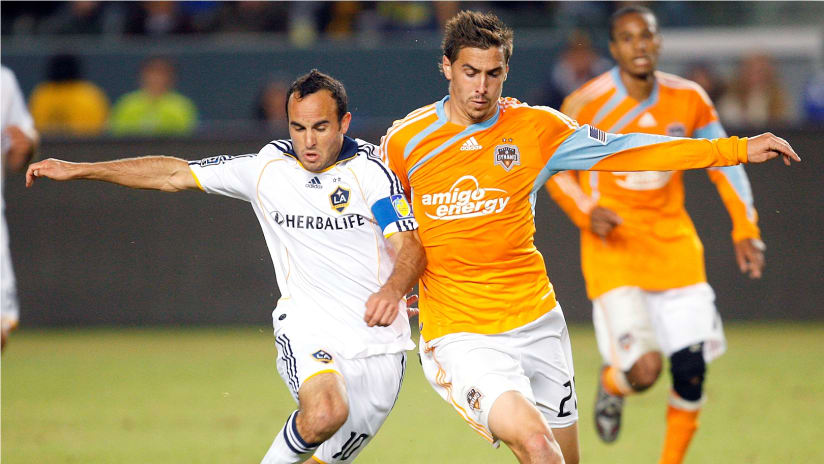This article appeared in the April 1, 2010 issue of the Houston Dynamo Gameday Magazine.
Where others saw little, Dominic Kinnear saw promise. It worked for Geoff Cameron, as the third-round draft pick made the Dynamo roster and became a valuable contributor and Rookie of the Year finalist in 2008.
Where others saw a role player, Dominic Kinnear saw a starter. It worked out for Geoff Cameron, as he moved to center back and became an MLS Best XI selection and Defender of the Year finalist in 2009.
Where others see a defender, Dominic Kinnear sees an attacking midfielder. How will it work out for the Dynamo and Cameron in 2010?
If
recent history is any indication, very well indeed.
BUILDING AROUND
CAMERON
The preseason questions for Kinnear and co. are all about trying
to replace Stuart Holden and Ricardo Clark in the center of the Dynamo midfield.
From a Houston perspective, however, there was really only one hole to fill;
Kinnear knew Cameron could man the other.
“In a couple of games last year he played holding midfielder, but I think he can play attacking midfielder,” Kinnear said. “I think he’s got to find his feet and get himself more comfortable in there, but I don’t think you can peg him down to one. I think he can play both.”
With that settled, Kinnear and assistant coaches John Spencer and Tim Hanley tried out plenty of options but eventually settled on Jamaican Lovel Palmer and former Dynamo player Adrian Serioux to join Richard Mulrooney as candidates to play centrally behind Cameron.
Building a team around Cameron would have been unthinkable two years ago, when the Dynamo snagged the 6-foot-3 native of Attleboro, Mass., late in the third round of the 2008 MLS SuperDraft.
“I JUST WANTED TO MAKE THE PRACTICE
SQUAD”
Cameron was an all-star attacking midfielder in college, earning
Atlantic 10 Midfielder of the Year honors as a senior at the University of Rhode
Island. But nobody knew exactly where he would “project,” in scouting parlance,
at the next level. It didn’t matter to Cameron.
“To be honest, my first idea was I just wanted to make the practice squad,” Cameron said. “The reserve team was my goal.”
He got a lot more than he bargained for. The Dynamo tried Cameron in a few places – including a brief stint at forward in the Pan-Pacific Championship in Hawaii – and quickly became convinced they needed to keep him, no matter where he played.
“We took a chance on someone who came in, worked hard, and showed us he had good quality on the ball,” Kinnear said. “He’s just a good player – that helps – and I think he was open to playing anywhere to try and get himself on the field, and then he pretty much excelled at whatever position he played.”
Cameron burst onto the scene in his first MLS home game, scoring a dramatic game-tying goal in stoppage time against rival FC Dallas. That play – a run into the center from right midfield, it should be noted – seemed to put him on the map, and he saw plenty of playing time the rest of the season. Wherever he lined up, the Dynamo found a way to use his talents. If it was at right midfield in a reserve game, every goal kick was aimed his way to capitalize on his size advantage. When he lined up at center back in SuperLiga, other players covered for him while he made his patented surging runs forward.
The Dynamo’s run to the final gave Kinnear the confidence that Cameron could play anywhere. So in 2009, with Eddie Robinson injured and Andrew Hainault’s signing held up by a crooked front office in the Czech Republic, Cameron was asked to step in at center back, and he stayed there most of the year, although he did make cameos at five other spots.
Along the way, he found quite a bit of success partnering with
Bobby Boswell, leading to a spot on the MLS Best XI. He even made the Dynamo’s
defensive play of the year in October with a bicycle kick to clear a ball off
the goal line against the Galaxy.
A DIFFERENT CHALLENGE
In his
third MLS season, a third different challenge awaits Cameron: running the team’s
offense from the attacking midfield spot in Kinnear’s vaunted 4-4-2 formation.
Kinnear does not put that whole burden on Cameron – after all, the Dynamo have
always been a cross-and-finish offense; rather, he wants Cameron to play to his
strengths.
“In that position, what we want from our guys is good late runs into the box and good late runs beyond the forwards,” Kinnear said. “We want him to keep it simple and keep the ball moving in certain areas, but always try to have his eye out and be goal-hungry. We think he has the range to be able to make those long runs beyond the defense, or if the ball goes wide make late runs into the box.”
With work rate and determination already part of his game, Cameron will have to adjust to different passing angles this year, and all eyes will be on him for consistent accuracy. But if he can continue to conjure up moments of brilliance – like his impromptu volley to set up Bobby Boswell’s tying goal in Toronto last July – he will have no problem at all.
“The
more you play and the more time you have in there, the more comfortable you
get,” Cameron said. “You’ve got to keep playing that position the way you’re
going to play it in a game, and that’s where you get your confidence. … I’m
going to try and do my share and run off the ball as much as I
can.”
RAISING THE LEVEL
Just as he took on the task of making the
team in 2008, Cameron is ready to take on the task of playmaker in
2010.
“If an opportunity is presented in front of you, you have to use it to your advantage,” Cameron said. “It’s hard in the beginning. It’s quicker, it’s faster, you’re playing with guys who are really, really good. Your level has to raise a lot higher.”
He was talking about himself as a rookie, but he may as well have been talking about this coming season. Where others see a challenge, Geoff Cameron sees an opportunity.
So far it has worked out well for the Dynamo and Dominic Kinnear, and they trust it will once again in 2010.





